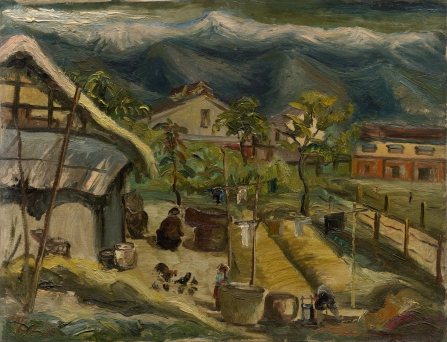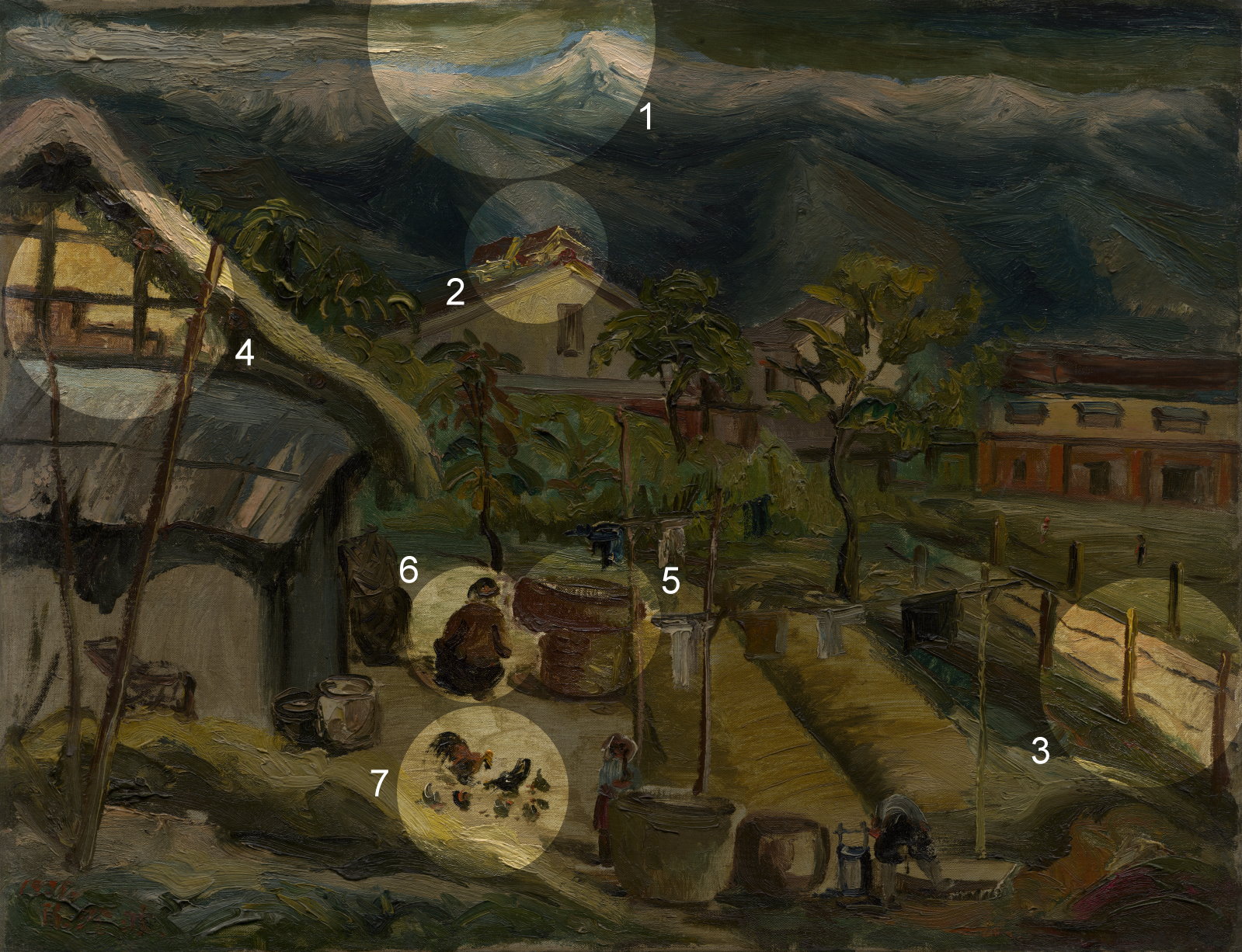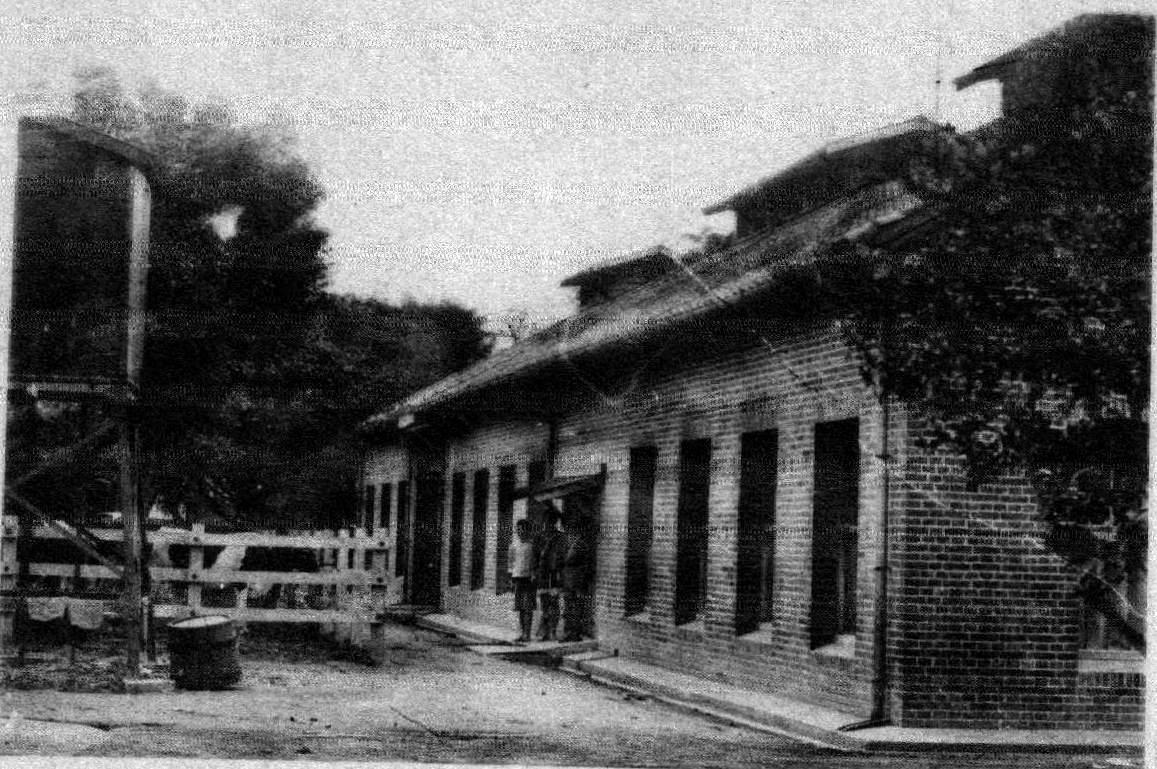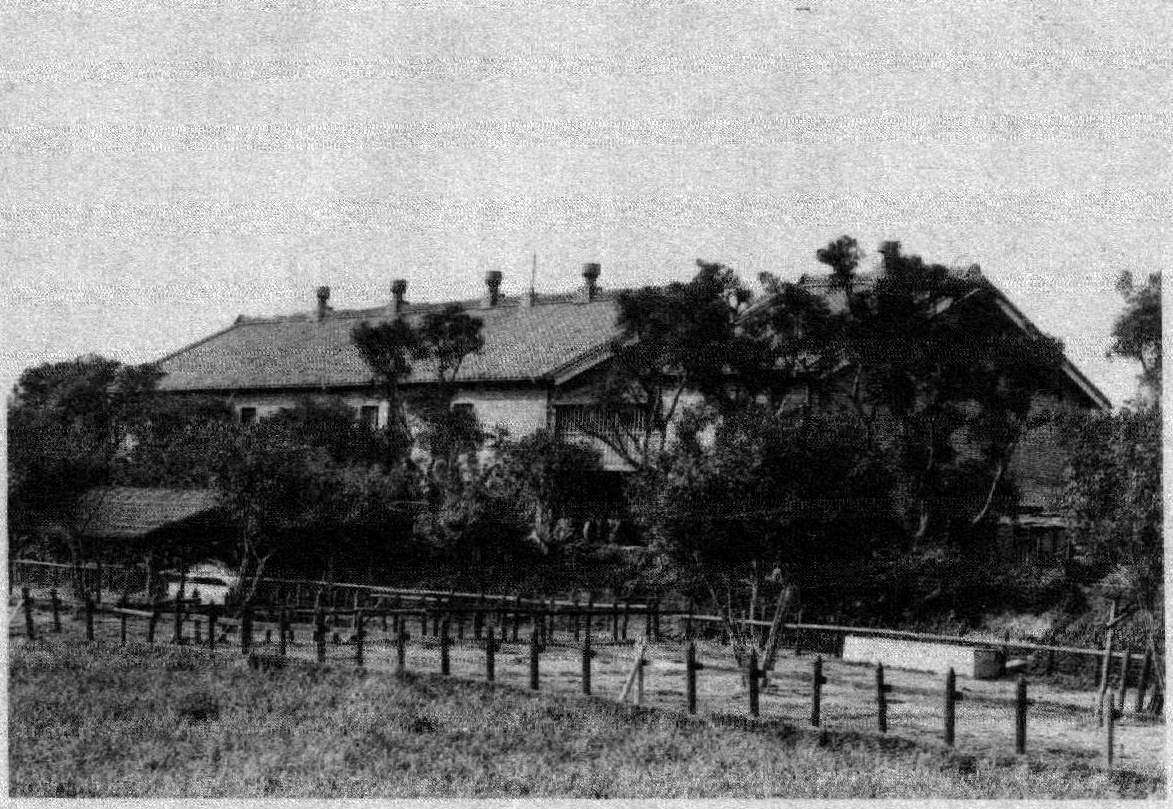嘉義郊外
為提供使用者有文書軟體選擇的權利,本文件為ODF開放文件格式,建議您安裝免費開源軟體 ([連結])

嘉義郊外
Chiayi Countryside
嘉義の郊外
1935, 畫布油彩, 49×64cm
oil on canvas
画布油彩
寧靜的鄉間氣氛卻擠滿了景物細節,一幅畫彷彿有說不盡的故事。院落裡,婦人的背影是整件作品的焦點。圍繞在周遭的雞群、孩子與晾衣架,都提示了她的默默勞動與辛勤付出。古樸農家的後方是現代化的牧場,三角形的屋頂接連著遠方山巒,營造出高低起伏的連綿動勢。而高聳的玉山總是屹立在陳澄波的畫作裡,它究竟象徵了什麼呢?
Infused with a quiet pastoral ambiance, this peaceful tableau in fact bustles with scenic details and bucolic vignettes. A woman in a farmyard, back turned to the viewer, serves as the focal point for the entire work. Surrounded by chickens, children, and clothing racks, she works diligently to complete her daily tasks. Beyond her rustic farmhouse stands a modernized cattle ranch and pasture for grazing. Triangular rooftops point upwards towards rolling hills and distant mountains, creating a sense of perpetual undulating movement. Towering above all, the magnificent Mount Jade rises prominently into view. What did this mountain, which appeared over and over again in Chen Cheng-po’s works, symbolize for the artist?
のどかな田舎らしい雰囲気の画面に、景物が細々と描き込まれています。1枚の絵に語り尽くせない物語があるかのようです。庭にいる女性の後姿が、作品全体の焦点です。鶏の群れや子供、物干し竿が取り囲まれて、黙々と働かねばならない女性の辛さを暗示しています。古めかしい農家の裏手にあるのは近代的な牧場です。三角形の屋根が遠くの山々に連なり、よどみない起伏のある動感が醸しだされています。陳澄波の画中にいつも、高く屹立して聳える玉山。いったい何を象徴しているのでしょうか。

1.作畫位置
Vantage point
作画地点
據陳澄波後人的回憶,這幅畫的創作地點應在「嘉義郊外乳農場」,當即舊地圖上市街西南方的嘉義牧場。畫中山巒的描繪亦可作為佐證,若從該地望向東方,前景的大武巒山便會向左偏移,而不再與後方的玉山山脈垂直相疊。
According to Chen’s descendants, this work was painted at the Chiayi Countryside Dairy Farm, which was located on old maps to the southwest of the city. This can be confirmed by the relative positions of the mountain ranges portrayed in the painting. Looking eastward from the farm, as compared to the view from Chiayi proper, the nearby Dawu Range would appear to have shifted left, affording a better view of the more distant Yushan (Mount Jade) Range.
陳澄波の子孫の記憶によれば、この作品が描かれた場所は「嘉義郊外の酪農牧場」と思われます。古い地図に記載のある、市街地西南に位置する嘉義牧場のことです。画中の山々の描写をその裏付けとすることができます。その場所から東を望むと、前景の大武巒山が左に移動して見え、後方の玉山山脈と垂直に重なることはありません。
2.太子樓
Rooftop ventilation windows
太子楼
大型屋舍的三角形屋頂中央有突出於屋脊的奇特構造,這是俗稱「太子樓」的換氣口。這樣的建築形制,時常應用於菸樓、穀倉等需要保持通風乾燥的場所。由於陳澄波的作畫地點在「乳農場」,這幢建物可能會是牛隻的畜舍。
The gable roof of the large, olive-green building features peculiar temple-like structures protruding from its ridge. Commonly known as “crown prince temples,” these windows provide ventilation for the building. This architectural design is often used in tobacco barns, granaries, and other facilities requiring sustained ventilation and low humidity. Since Chen painted Chiayi Countryside at a dairy farm, this building was perhaps a cowshed.
大型家屋の三角屋根中央に小さな屋根が突き出した特殊構造、俗に「太子楼」(越屋根)と言われる換気口です。このような建築様式は「菸楼」(タバコ製造のための建物)や穀物倉庫など、乾燥した風通しのよい環境が必要な建物によく見られます。陳澄波の作画地点は酪農牧場なので、この建物はおそらく乳牛の畜舎でしょう。

日治時期一座建有「太子樓」的牛舍。臺灣畜產株式會社,《臺灣畜產株式會社十周年誌》(臺北市:臺灣畜產株式會社,1930),前置頁3。國立臺灣大學藏。
A Japanese-era cowshed fitted with “crown prince temples” (rooftop ventilation windows). Taiwan Livestock Corporation Tenth-Anniversary Report, Taipei: Taiwan Livestock Corporation, 1930, pp. iii.
日本統治時代にあった「太子楼」の牛舎。台湾畜産株式会社,『台湾畜産株式会社十周年誌』(台北市:台湾畜産株式会社,1930),前置p.3。
3.牧場的圍欄
Pasture fencing
牧場の柵
畫面右側的道路兩旁描繪了繩索與木樁構成的圍欄,這應當是牧場用於防止牲畜走脫的繩柵。日治時期,飲用牛乳的習慣在臺灣漸漸普及,日本業者引進了養牛榨乳的技術,專門生產牛乳的牧場,也隨之出現在各大城市的郊區。
The road on the right side of the canvas is lined by fencing made of rope and wooden posts. This fencing was most likely put in place to prevent cows from wandering off the property. Soon after Japanese businesses introduced milking equipment and techniques to Taiwan, dairy farms sprung into operation in the outskirts of big cities across the island, and the practice of drinking milk gradually gained in popularity.
画面右側の道の両脇にある、木材と縄で作られた柵は、牧場の家畜が逃げないように設置されたものでしょう。日本統治時代、台湾でも牛乳を飲む習慣が徐々に広まり、日本の業者が乳牛の飼育法や搾乳の技術を台湾に持ち込みました。それに伴って、牛乳を専門に生産する牧場も各地の大都市郊外に建設されました。

日治時期臺灣畜產株式會社的牧場柵欄。臺灣畜產株式會社,《臺灣畜產株式會社十周年誌》(臺北市:臺灣畜產株式會社,1930),前置頁4。國立臺灣大學藏。
A fence encloses a pasture owned by the Taiwan Livestock Corporation. Taiwan Livestock Corporation Tenth-Anniversary Report, Taipei: Taiwan Livestock Corporation, 1930, pp. iv.
日本統治時代の台湾畜産株式会社の牧場柵。台湾畜産株式会社,『台湾畜産株式会社十周年誌』(台北市:台湾畜産株式会社,1930),前置p.4
4.竹管仔厝
Bamboo homes
竹管仔厝
房子的屋頂覆蓋著茅草,山牆上還可以看到橫豎交錯的竹條,這是過去臺灣鄉間常見的「竹管仔厝」,以較粗硬的竹子做屋架及桁梁,再用細竹編成牆面,抹上泥灰。這種形制簡單的房舍,承載了許多老一輩臺灣人的共同記憶。
Thatched with cogon grass, the farmhouse roof rests above a gable wall composed of interlaced horizontal and vertical bamboo slats. In the past, such homes were a common sight throughout the Taiwanese countryside. Thicker, stronger stalks of bamboo were used as posts and beams to frame the house, while thinner stalks were woven together and coated with plaster to form supporting walls. Though simple in design, these bamboo homes evoke powerful collective memories among Taiwan’s older generation.
家屋の屋根を覆うようなカヤと、「山牆」(破風)のうえに格子状に組まれた竹。かつては台湾の田舎でよく見られた「竹管仔厝」です。硬く太い竹で屋根の小屋組み、桁や梁をこしらえ、細い竹で壁を組んでから漆喰を塗ります。こうした簡素な作りの家は台湾のお年寄りに共通する思い出です。
5.石磨
Stone mortars and pestles or millstones
石臼
上寬下窄、看來頗為笨重的大型器物,可能是石製的舂臼或磨盤。前者用來搗米去糠,精製白米;後者則用於製作米漿以及米粉。長久以來,稻米一直是臺灣社會的主食,處理米穀的各種衍生工具,也成為農村當中的特色風景。
Slightly wider at the top than bottom and appearing rather unwieldy, the large agricultural implement in the center of the painting is possibly a stone mortar and pestle or a millstone. Whereas mortars and pestles were used to produce rice milk and flour, millstones were used to husk and refine rice. Since rice has long served as a staple of the Taiwanese diet, such rice-processing tools are a distinctive element of traditional farm village scenery.
とても重そうで口の広い道具は、おそらく石製の「舂臼」か「磨盤」でしょう。前者は精米に、後者は「米漿」(米で作った飲料)や米粉を作るのに使われました。台湾では古くから米を主食としており、米穀を処理するために作られた様々な道具類も農村風景の特色となっています。
6.婦女
The role of women
女性
穿著大襟衫、挽起頭髮的婦人,正蹲坐在石磨邊默默勞動。舊時的臺灣社會,女性是家庭的重要支柱,她們不只要打理家內事務,也得承擔各種工作。這幅畫裡所提及的飼雞、洗衣、舂米、照顧孩子……通常都由女性一手包辦。
Wearing simple clothing and with her hair tied up, a woman crouches next to a millstone and quietly labors away. In traditional Taiwanese society, the contributions of women were crucial for the smooth functioning of households. As this painting suggests, women were responsible for attending to all domestic matters, such as feeding chickens, washing clothes, pounding rice, and taking care of children. Almost without exception, this entire laundry list of tasks was completed exclusively by the women of the household.
「大襟衫」(当時の庶民の衣服)を着て、髪を高く結った女性が、石臼の前にしゃがんで黙々と作業をしています。この時代の台湾社会では、女性が家庭を支える大黒柱的存在で、家事はもちろんのこと、いろいろな仕事もこなしていました。この絵に描かれている養鶏や洗濯、米搗き、子供の世話……一般的にこれら全てを女性が一手に担っていました。
7.飼雞
Feeding chickens
養鶏
傳統時代,臺灣的農家除了耕田種地之外,多半會兼營其他副業,畜養家禽是常見的選擇。飼養雞隻,在早期平埔族的日常生活當中便已能得見。十八世紀初的《諸羅縣志》當中,就可以見到雞隻在杵臼旁啄食米粒的有趣圖景。
In the past, Taiwanese farmers often operated secondary businesses alongside their mainstay of crop cultivation. Many chose to raise poultry, similar to the practice of indigenous peoples living in lowland regions who had long raised chickens. Dating back to the early 18th century, this amusing drawing from The Gazetteer of Zhulou County shows a chicken pecking at grains of rice spilling forth from a large mortar and pestle.
伝統的な暮らしを送っていた頃は、田畑の耕作のほかに副業を行う農家も多く、家畜の飼育が一般的な副業でした。養鶏は往時の平埔族(台湾の平野に暮らす原住民族)の暮らしでよく見られました。18世紀初頭の『諸羅県志』には、杵と臼を使う人の傍らで米粒を啄ばむ鶏の絵図が収録されています。

《諸羅縣志》裡的「番俗圖」。
Indigenous Life from The Gazetteer of Zhuluo County
『諸羅県志』所収の「番俗図」。
